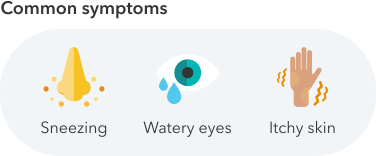Let's talk aboutCat Allergy
What is cat allergy?
Allergies occur when the immune system mistakes a normally harmless substance, called an allergen, for a harmful one. When the immune system detects an allergen, it triggers an immune reaction in an attempt to protect the body. In the case of cat allergy, the immune system reacts to certain proteins found in cats’ saliva, skin cells (also called “dander”), or urine.
Symptoms of cat allergy
Those with cat allergies often experience sneezing, runny nose, watery eyes, and itchy skin. Some may experience signs of asthma, such as difficulty breathing or wheezing. For people with cat allergies, lifestyle modifications and other treatments, including medications, can help ease symptoms.

Did you know?
It is estimated that around 12% of people in the U.S. are allergic to cats. Unfortunately, preventing reactions may not be as simple as only avoiding direct contact. Pet allergens can travel through the air and stick to clothing and other surfaces, easily spreading from place to place. Around 50% of U.S. households own a cat or a dog, yet studies have shown that detectable levels of pet allergens can be found in almost all homes, even ones that don’t own pets. High levels of pet allergens have also been found in public places like schools, offices, and public transportation vehicles. To prevent reactions, experts recommend washing hands and clothes frequently.

Explore more
Curious whether you have an increased likelihood of developing a cat allergy based on your genetics? 23andMe takes into account more than 11,500 genetic markers to estimate the likelihood of developing a cat allergy. Find out more with the Cat Allergy Wellness report (Powered by 23andMe Research), part of the 23andMe+ Premium membership. 23andMe+ Premium includes everything in our Health + Ancestry Service plus new premium reports and features throughout the year.

23andMe+ Premium
References